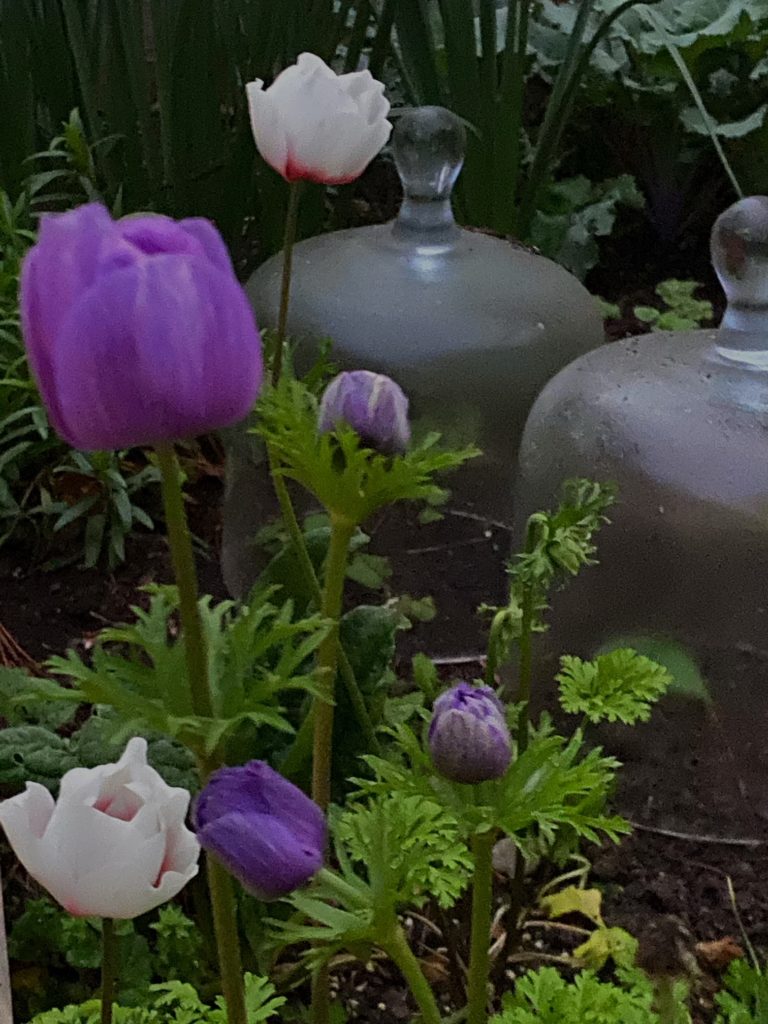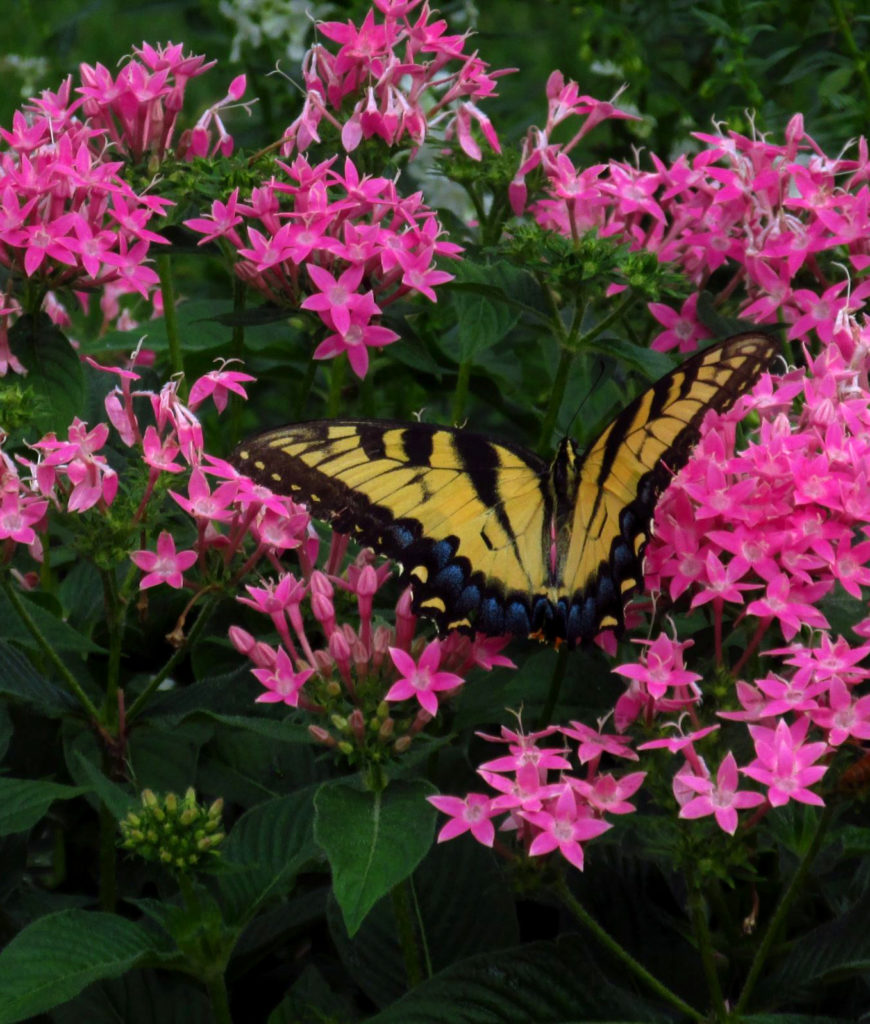
Back in the day, Martha Stewart would share something wonderful (a tool, a kitchen gadget) and declare “It’s a Good Thing”, and we believed her.
This month I thought I would share a few of my favorite things, from overalls to garden tools – and maybe even a plant or two.

WORK OVERALLS. I never thought I would own a pair of overalls for outdoor work until I walked into Duluth Trading Company one day last fall, and found the perfect thing to replace those old jeans with clay-stained knees. These ladies’ overalls are lightweight but tough, comfortable (because there is no waist), and have various pockets for phone/pruners/plant tags. They are just right for outdoor work in cool spring weather.

GLASS CLOCHES. I bought several of these as garden décor years ago, but I now use them to protect small plants or seedlings in early spring when frost threatens. They look great and work well on cold spring nights when a panel of frost cloth would be overkill.
THE SOUTHERN LIVING GARDENING BOOK. My mom bought me the first edition of this treasure 30 years ago, and it often sat on my kitchen table where I would read while my young children were napping. New to the South, I was determined to figure out how to garden in this place with the sticky red clay soil. This book includes detailed descriptions of hundreds of plants, along with symbols for moisture and light requirements, which helps you find the right plant for the right place. There is a section in the front of the book that has categories such as Plants for Damp Areas, and Drought-Tolerant Plants, which is so helpful for new gardeners looking for guidance.
ESPOMA PLANT TONE. This has been my go-to organic fertilizer for 30 plus years. Espoma produces specialty fertilizers such as Rose Tone and Tree Tone, which I also use at times, but Plant Tone is a great general fertilizer that you can use across your entire garden. Holly Tone is their famous fertilizer for evergreens that require acid soil, such as camellias. It’s useful for gardeners who want to grow hollies, etc. in soil that tends to be alkaline or neutral. (I don’t need to use it because my soil is already acidic.)
THE VEGEPOD. This Australian raised-bed gardening system was a Christmas gift from my husband. I thought “How sweet, but do I really need this big thing?” It’s grown on me in the last five years, and now I can’t really imagine not having it. It is self-watering thanks to a reservoir that sits at the bottom of the unit and also has a tough mesh cover that allows me to grow things like lettuce and spinach well into December. The mesh cover also acts as shade cloth in the heat of summer. I don’t grow summer produce in it, though some people do, but I love to use it for cuttings, which root very quickly in the consistent moisture, and also for growing things like foxgloves from seed.

SALVIA ‘SKYSCRAPER PINK’. Beloved by hummingbirds and bees, these salvias are simply perfection from early summer until frost. I would consider this an annual, though it may be perennial just south of my zone. I have had no luck keeping it in the ground over winter in zone 8a, so I order new plants each spring. They are deer and rabbit proof, a plus for those of us dealing with such things. These salvias will always have a place somewhere in my garden.
PERMATILL. This soil amendment is made from slate that is heated to 2000 degrees Fahrenheit, which causes it to expand. These expanded slate chips are excellent for gardens like mine with stubborn red clay. I combine one part Permatill to two parts soil conditioner (ground bark) to use as a soil amendment when I’m creating a new bed. This works extremely well for garden areas that tend to hold onto moisture. If I need to prepare a drier area, I substitute compost plus Permatill. It’s a game changer.
CHICKEN GRIT. I grab a bag of this stone product whenever I’m at a feed store. I would use horticultural grit (if I ever saw it for sale) but this is a good substitute. It is useful for sprinkling around plants where you have slug and snail activity, as a topdressing for succulent pots, or it can be mixed with potting soil if you need to lighten it up. I also like to use it to mark where I’ve planted seeds in pockets between plants.
RODALE’S FLOWER GARDEN PROBLEM SOLVER. This is an old book that I’ve had forever and I reach for it when I have a garden pest issue that I want to solve without using harsh chemicals. If you’ve never heard of the Rodale Institute, it has been around for 75 years, founded long before organics and regenerative agriculture became news. Here I find detailed information on plant diseases and pests, with research-based solutions. I’m an organic gardener and for that reason I’m always looking for the least toxic way to deal with a pest. Often I simply leave things alone and let nature take care of the aphids or whatever it might be, but when I’m really puzzled about something in the garden, this is the book I turn to. (The web is great, but there is alot of incorrect info floating around out there.)
RAIN BARREL. I never knew how much I needed this until my husband bought me one on a trip to Costco a few years ago. It’s easy to find one that will blend in with the exterior of your house, so if you don’t have one, it’s worth considering. Mine sits near the back corner of the house and it allows me quick access to water for my garden without walking to a hose bib. Unless I’m watering big areas of the garden in the dog days of summer, I fill watering cans from this source. Plants love rainwater because it is free of chlorine.
I’m dodging raindrops this week in the garden, but here’s something that has captured my attention:
I’ve begun to see a single Monarch butterfly fluttering around the garden every few days, which means they’ve begun to return to my area to breed, which is fantastic! I’ve just planted an ‘Orange Scepter’ buddleia and also a ‘Cinderella’ asclepias, which should be popular in addition to the 14 abelias that are in various parts of my garden. Abelia ‘Canyon Creek’ is hands down their favorite stop for nectar once it starts blooming in early summer, and so I keep this group of shrubs at the five or six foot mark for maximum blooms through the season. Happy Gardening!
